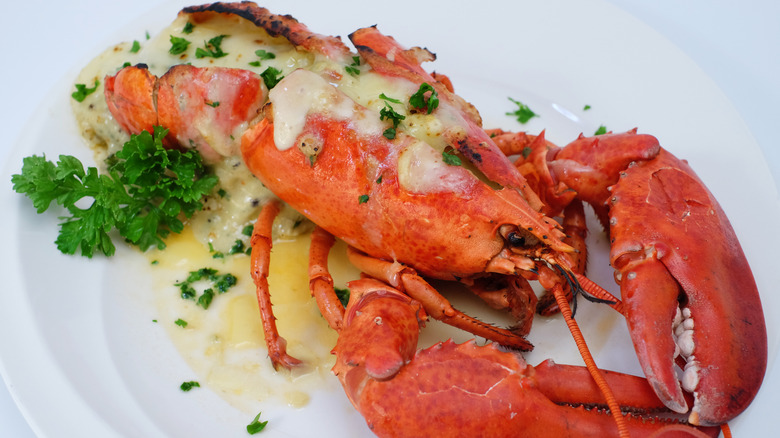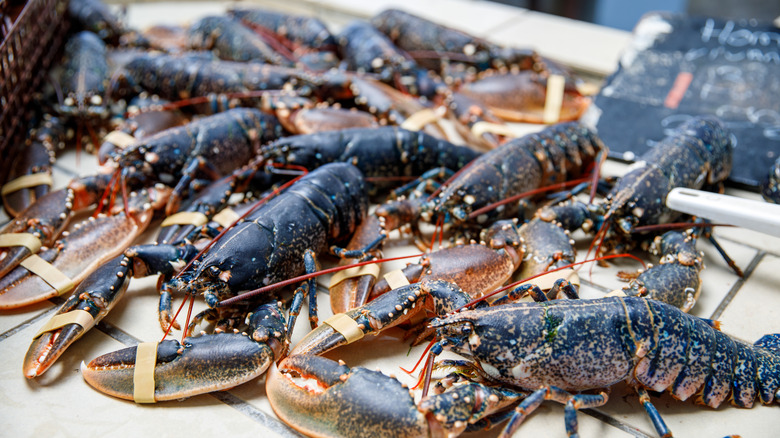The Unexpected Origin Story Of Lobster Thermidor
Lobster Thermidor is a French dish that has classically been associated with decadence, and it's easy to see why. Aside from the pricy shellfish and cognac it cooks in, other rich ingredients include heavy cream, butter, and Gruyere cheese. Even the presentation isn't subtle with the cooked lobster meat incorporated into a highly-flavored cream sauce that's spooned inside a lobster shell, which is then covered with cheese and baked until bubbly. The opulence of the dish and the fact that it isn't very common to find in restaurants might lead you to think it was initially created for royalty or superheroes like Bruce Wayne (according to the Lego Batman Movie, it's his favorite dish).
And then there's the fact that Napoleon Bonaparte may have had something to do with the origins of the dish. But, truthfully, the theory regarding France's most famous general is murky at best. Legend has it that Napoleon first ate lobster Thermidor in the French Republican Calendar month known as Thermidor, from July 19 through August 17, when the weather is exceptionally warm in the European country. Yet, a wider known and perhaps more probable tale suggests that the dish was actually named for a short-lived, Parisian play that debuted decades after Napoleon's death and was created by a respected French chef.
What the theater had to do with lobster Thermidor
On January 24, 1891, Victorien Sardou's controversial play "Thermidor," about the French Revolution, debuted in Paris. In celebration of the inaugural performance, chef Léopold Étienne Mourier created a lobster dish, naming it after the play and presenting it to the actors and theater crew at his restaurant, Chez Marie.
The play only lasted for three nights because of its questionable content, which criticized the French Revolutionary Maximilien Robespierre, but lobster Thermidor had already made its mark, with other chefs like Auguste Escoffier taking note; he included a recipe for the dish in one of his own cookbooks, published in 1903.
By the turn of the 20th century, lobster Thermidor had crossed the pond to America, particularly New York hot spots. The Hotel Knickerbocker featured the dish on their menu in 1907; by 1915, it was at the Waldorf Astoria; and in 1917, Delmonico's was serving the dish. Interestingly enough, the latter created a similar entrée called Lobster Newberg in 1876, which is still served at the restaurant today.
Many people consider January 24 to be National Lobster Thermidor Day as it marks the date when the entrée was first created in 1891. It's the perfect time to treat yourself to the elusive dish, but if you can't find it at a restaurant near you, you can always tackle the recipe on your own.
How the dish eventually caught on in America
It's a well-known fact that lobster didn't always have a luxe reputation (and high price to go with it). Around the time that the first Pilgrims arrived in North America, lobster was incredibly abundant in the northeastern seaboard and in Canada, and they may have even been served at the first Thanksgiving. Even through the 1840s, the shellfish was cheap and considered suitable for prisoners and poor apprentices, rather than dignitaries and wealthy landowners. But, in Europe, it was quite the opposite, and lobster was, indeed, a fancy food.
The appeal of lobster as a delicacy really began to soar upon the expansion of the American railroad during the 1880s; canned lobster could suddenly travel to other states safely and folks outside the East Coast developed a taste for it, so much so that they would travel to the New England states for leisure and fill up on fresh lobster meat. Naturally, the prices and reputation of the shellfish rose. This would have been right around the time that lobster Thermidor was born (remember, it first appeared in 1891) and would arrive in America a little over a decade later when lobster was popular in restaurants suited for well-to-do patrons. Consider this fact: Lobster Thermidor was priced at $1.75 at the Waldorf Astoria hotel in 1915, which is the equivalent of $53.15 in 2024.
It's interesting to think that, if the gourmet seafood hadn't experienced a renaissance of sorts when it did, lobster Thermidor may not have caught on in the New World at all.



